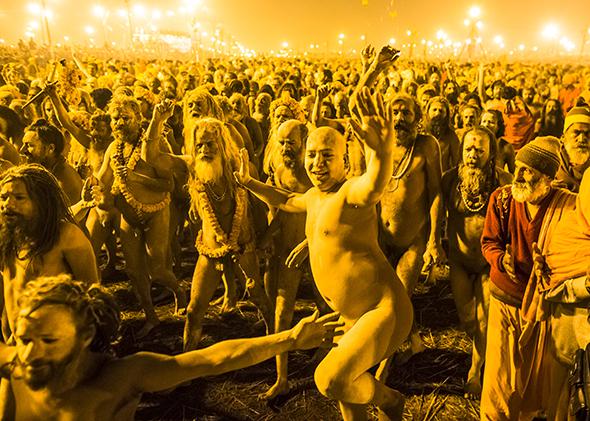The World Health Organization is worried about this year’s Hajj. Beginning in early October, more than 2 million people will voluntarily gather in the home country of a novel and untreatable virus called MERS that has already infected nearly 700 people and killed more than 200. Respiratory illnesses are only the beginning of the many dangers faced at religious pilgrimages, though. Pilgrims should worry about fires, stampedes, diarrhea, and guns. In fact, if you’re in a hurry to meet your maker, a religious pilgrimage may be the most direct route.
The most catastrophic Hajj in recent history occurred in 1990, when a rush to escape 112-degree heat resulted in 1,426 people being trampled to death inside an air-conditioned tunnel. The stoning of the devil ritual that occurs near the end of the gathering leads to stampedes with disturbing frequency. Hundreds were trampled in the 1994, 1998, 2004, and 2006 pilgrimages. Despite logistical and infrastructure improvements, the smallest incidents continue to trigger mass casualties, demonstrating just how fine the margins of safety are in crowds of millions. The 2006 stampede occurred after suitcases tripped pilgrims in the front of the procession. A 2003 trampling was the result of two crowds coming into contact while moving in opposite directions. In 1998, several pilgrims fell from an overpass, causing a panic.
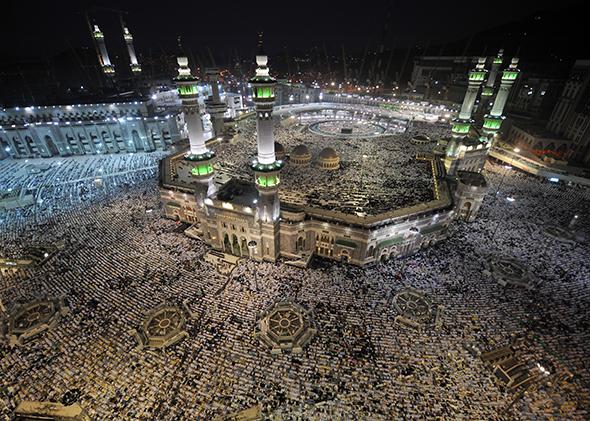
Photo by Fayez Nureldine/AFP/Getty Images
There are plenty of other ways beyond stampedes to die en masse at the Hajj. In 1997, a fire swept through the tent city, killing 340 and burning 1,500. Security forces killed hundreds following the seizure of the Grand Mosque in 1979 and dozens during anti-U.S. protests in 1987. Pandemic diseases are nearly as old as the pilgrimage itself. A malaria outbreak among pilgrims was recorded in 632, just two years after Muhammad himself led the first Hajj. A modern day pilgrim’s risk of contracting tuberculosis during the Hajj is a whopping 10 percent.
A 2013 study of Iranian pilgrims traveling to Mecca estimated the death rate at 42 per 100,000, which is an astonishingly high figure for a five-day event in which young and healthy people are disproportionately represented. But here’s the surprising part: The Hajj is one of the world’s safer religious pilgrimages.
“The Hajj is annual and always occurs in the same place, so there is some infrastructure in place, including crowd control systems,” says Pooja Agrawal of the Yale School of Medicine, who studies humanitarian crises and forced migration.
Saudi officials have done an admirable job of organizing the chaos. They introduced pilgrim permits for 2013 in an attempt to limit the numbers and to ensure that all visitors are vaccinated against polio, yellow fever, and meningitis. A team of doctors monitors infection transmission data. The government intensifies mosquito spraying in the weeks before the Hajj, paying special attention to areas that will house pilgrims from countries where malaria is endemic. Engineers continuously inspect water treatment plants throughout the event to limit gastrointestinal disease.
The Kumbh Mela, a Hindu religious festival that Agrawal has studied in detail, has all of the same problems as the Hajj—stampeding, infection, and fire—plus many more. Most problematically, it is held at several different locations on a complicated rotating schedule. “Organizers have to reinvent the wheel for every event,” she says.
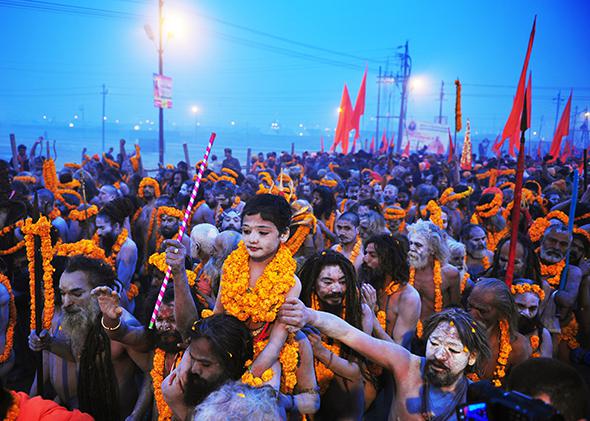
Photo by Sanjay Kanojia/AFP/Getty Images
The Kumbh dwarfs the Hajj in attendance, with as many as 100 million people, many of them unvaccinated, attending the event. It’s the largest religious festival in the world. To fire, which is the most terrifying elemental danger at large gatherings, the Kumbh adds water. Each festival is based around a holy river, and pilgrims surge in large groups to the water every few days to perform sacred rituals. Drownings are common, and they are a serious problem in a country where most people never learn to swim. Government boats patrol the shoreline looking for pilgrims struggling in the current.
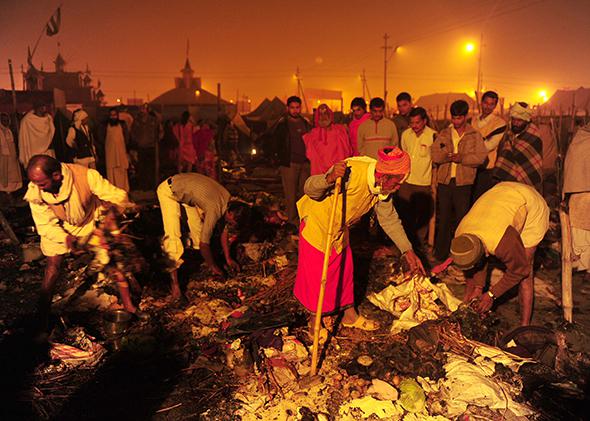
Photo by Sanjay Kanojia/AFP/Getty Images
The water is also a major source of disease. Pilgrims pitch their tents on a flood plain that is submerged 10 months out of the year. In that environment, mosquito-borne diseases are a major problem. So is giardia. Although Indian officials dig pit latrines around the tent city where pilgrims live for six weeks, there aren’t enough holes to handle the waste. Even if there were enough latrines, many people wouldn’t use them. The World Bank estimates that more than half of Indians practice open defecation, and one of the platforms of Prime Minister Narendra Modi’s campaign was building toilets before temples. When you live in a village, open defecation is bad. If you’re defecating on the banks of a river that supplies cooking and bathing water to millions of people within a couple of miles, it’s a disaster waiting to happen.
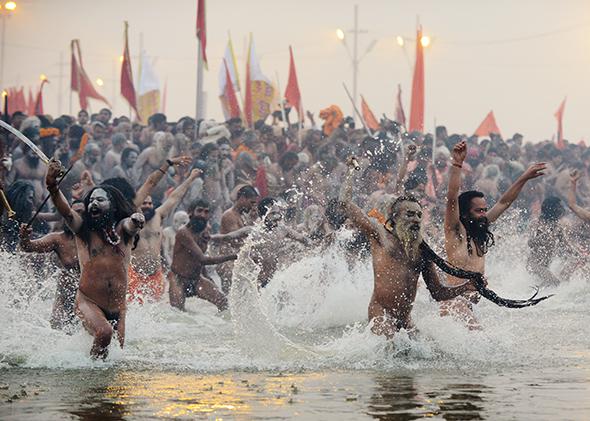
Photo by Roberto Schmidt/AFP/Getty Images
No one really knows how many people contract waterborne illnesses at the Kumbh Mela. Although Indian state governments are to be commended for providing health care and food at the massive pilgrimage, they haven’t gathered sufficient public health data required to improve their services.
“All of the documentation is done by hand,” says Agrawal. “When the volume of patients is high, the doctors aren’t able to keep up and stop writing everything down in patient registers. The oversight breaks down, and it shows when you see the discordance between patient illnesses and what medications are available.”
The Hajj and the Kumbh Mela are just two examples of many dangerous gatherings. This year, 14 people died in a stampede at a religious event near a mosque in northwest China. Minimizing deaths at mass gatherings is an entire field of medical research. Although the problems are not limited to religious festivals—11 people died at a 1979 concert for The Who (the band), and the WHO (the global health group) found poliovirus in the sewage of a World Cup city this week—pilgrims seem to be involved in the worst disasters.
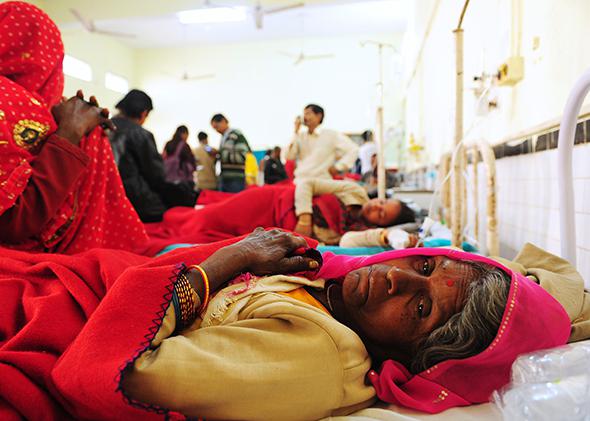
Photo by Sanjay Kanojia/AFP/Getty Images
The current concern about MERS is justified, but it should be used as an entry point for a broader discussion about the health implications of gathering millions of people together with inadequate organization or provision of health care. Some problems, such as respiratory infections, are probably unavoidable, but even those can be controlled with improved monitoring, sanitation, and education about hygiene. Pilgrims shouldn’t have to risk their lives to fulfill their obligation to God.
